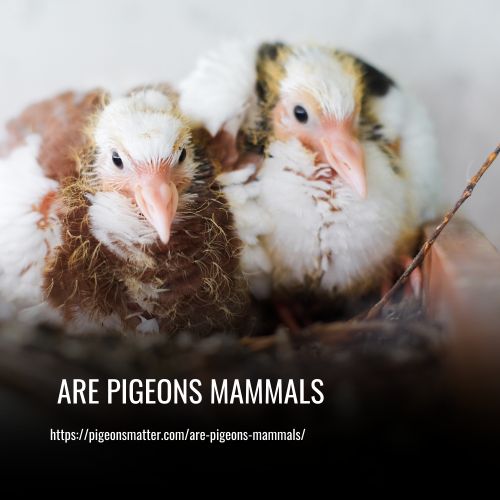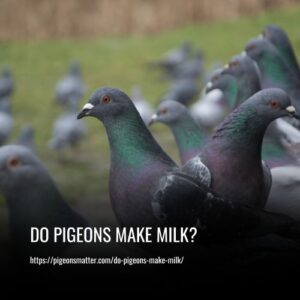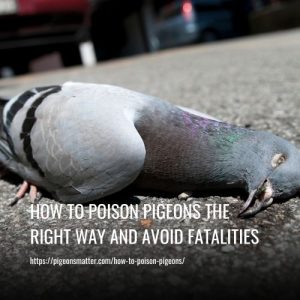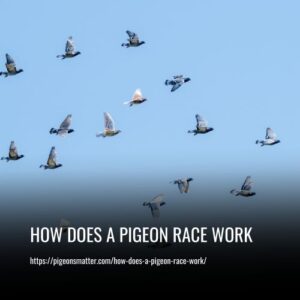Despite sharing some similarities with mammals, such as being warm-blooded and having vertebrae, pigeons are not classified as mammals. This is because, unlike mammals, they lay eggs as their means of reproduction.
Although some people may mistakenly consider pigeons as mammals due to certain similarities, it is important to understand their classification as birds and the unique characteristics that distinguish them from mammals.

Breeding pigeons and doves
Breeding pigeons and doves is not an easy task due to the great variation in their sexual characteristics. While some species are sexually monochromatic, meaning that males and females look almost identical, others are dichromatic and have distinct physical differences between sexes. This diversity makes sexing doves and pigeons a challenging task, and breeders have to carefully observe physical traits to determine the gender of their birds.
Doves and pigeons use simple materials like sticks and debris to build their nests, and their nesting location varies based on the bird species and habitat. It’s not unusual to find pigeon nests in high tree branches or on the ground.
However, domesticated pigeons normally have nest boxes that are given to them by their keepers. These boxes help them avoid territorial aggression and create a safe environment for parent birds and their offspring.
Doves and pigeons lay one or two eggs during each breeding season. Both the male and female birds share the duties of rearing their young and incubating the eggs for a period of time before hatching. In a unique characteristic, doves and pigeons produce a highly nutritious liquid called “crop milk” to feed their young. This milk-like substance is created through the secretion of fluid-filled cells from the lining of the crop, and amazingly, both male and female birds can produce it.
Young doves and pigeons, known as “squabs” are born without feathers and totally dependent on their parents. They are kept in the safety of their nest for 7 to 28 days, depending on the species, before leaving to explore their new world. Despite being non-mammals, doves and pigeons have developed an important parenting behavior that involves nutrient-rich, crop milk care for their young.
Don’t Pigeons Feed Their Babies With Milk?
Pigeons and doves do not feed their young with milk, but rather with a specialized substance known as crop milk. This highly nutritious substance is formed from protein-rich cells that line the parents’ crop, a pouch in the throat that stores food before digestion.
Crop milk is a semi-solid substance that contains antioxidants, antibodies, and helpful bacteria. Interestingly, its production is controlled by the hormone prolactin, which also regulates lactation in mammals. Like milk from mammals, crop milk is lactose-free and contains immune-boosting ingredients.
Unlike mammalian milk, crop milk is not delivered through teats or grooves, but is instead regurgitated from the parent to the squab. For the first week after hatching, the squab is fed exclusively on crop milk. In an unusual twist, both the mother and father can produce crop milk, making them unique among non-mammalian species.
It’s worth noting that crop milk is not unique to pigeons and doves, as other bird species such as flamingos and emperor penguins also use a similar substance to feed their young. However, only female mammals produce milk for their offspring.
How Do Birds Take Care of Their Young?
Birds have varying methods of parenting their young, depending on their species. Newborn chicks are usually born naked, blind, and vulnerable, requiring at least one parent to provide them warmth, protection, and sustenance. Some birds, such as the great frigatebird, are dedicated parents and care for their chicks for nearly two years.
To nourish their young, some birds feed their chicks crop milk, while others provide soft-bodied insects or bits of prey regurgitated from their own meals, such as small mammals, reptiles, or birds. Even after some chicks start growing feathers, they still depend on their parents for several weeks before becoming independent. Raising their young can be so labor-intensive that some bird parents enlist the help of their previous broods.
Unlike mammals who carry their young in their wombs or pouches, birds keep their young in nests until they are able to fly. The nests can be found hidden in trees, houses, or underground. Newborns rely on their parent birds to keep them warm until they sprout baby feathers and later mature into adult feathers.
More Reasons Why Birds Aren’t Mammals
Birds are uniquely different from mammals in many ways. Firstly, birds have wings, which is an attribute that most mammals do not possess. Not all birds can fly, but even birds that cannot fly have wings that serve other purposes. For instance, the emu has vestigial wings that provide balance while running. In contrast, the only mammals with wings are bats, whose wings are their hands. Interestingly, bats can outmaneuver birds with their wings which gives them more agility.
Unlike mammals, birds are descendants of the theropod dinosaurs. Many scientists regard them as a type of reptile, which makes them younger than reptiles and mammals. Birds appeared around 140 million years ago and diversified widely after the asteroid extinction event that killed off the other dinosaurs 60 million years ago. Birds evolved into a dazzling array of forms, with some species being as tiny as hummingbirds and others as massive as 9-foot-tall ostriches.
Birds also have unique skeletal structures that separate them from mammals. Their bones have hollow spaces, which make them lightweight and allow them to fly efficiently. Even the largest bird on earth, the ostrich, which gave up flying, weighs only around 286 pounds. This feature makes the flight mechanism a lot less strenuous on the bird’s body than in mammals, which are not equipped with such a feature.
FAQs
Pigeons are birds. They belong to the avian class of animals, characterized by feathers, beaks, laying eggs, and having wings.
No, pigeons, like other birds, do not produce milk. Mammals are unique in their ability to nurse their young with milk produced by mammary glands, a characteristic absent in birds.
Pigeons might occasionally be confused with mammals due to certain behaviors, such as cooing sounds or nesting behaviors, which might resemble some aspects of mammalian behaviors.
Pigeons, being birds, have feathers covering their bodies. Feathers serve various purposes such as insulation, flight, and protection.
Yes, pigeons are warm-blooded creatures, similar to mammals. Both birds and mammals are endothermic, meaning they can regulate their body temperature internally.
No, pigeons, being birds, lay eggs. Unlike mammals, which give birth to live offspring, pigeons lay eggs that hatch into chicks outside of their bodies.
Conclusion:
Pigeons are not mammals. While pigeons and mammals both produce milk to feed their young, the composition and production of pigeon milk differ significantly. Pigeons have a special crop of milk that is produced in epithelial cells in their crop, which is a pouch in their throat for food storage before digestion. This semi-solid substance is produced for just a couple of days and is not similar to milk from mammals in terms of composition.
This article can help individuals understand the unique characteristics of different species of birds, specifically pigeons. It provides insight into the special feeding behaviors of pigeons and the regulation of pigeon milk production by the hormone prolactin. Additionally, the article highlights the benefits of beneficial bacteria found in pigeon milk, which can act as immune boosters for baby pigeons.


